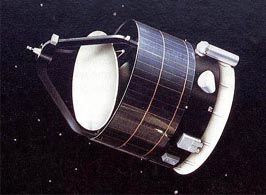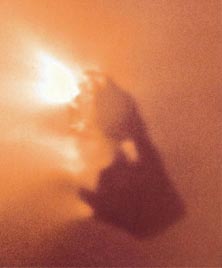Giotto Spacecraft
| The Giotto mission was designed to study Halley's Comet. The spacecraft encountered the comet on March 13, 1986, at a distance of 0.89 AU from the sun and 0.98 AU from the Earth and an angle of 107 degrees from the comet-sun line. The 1.5 m dish antenna, operating in the X-band was pointed toward the Earth. The goal was to come within 500 km of Halley's comet at closest encounter. The actual closest approach was measured at 596 km. |
 |
 |
Nucleus of Halley's CometWith such a long history of observations, we were well prepared for Halley's 1986 visit. The Soviet spacecraft Vega 2 traveled through the comet's coma, passing within 8000 km of the nucleus. With data obtained from that encounter, spacecraft Giotto was navigated to within 600 km of the nucleus and obtained our first direct images of a comet nucleus. Giotto's images showed the nucleus to be an irregular object, something like a potato, with dimensions 15 km long and up to 10 km wide. If the common "dirty snowball" view applies at all, this was a very dirty one, appearing almost jet black. The visible jets coming from the dark nucleus were not uniform, but emanated from several small vents on the sunlit side. These vents could actually produce measurable changes in the comet's orbit, and were our first clue about the origin of observed small departures of comet orbits from Kepler's laws. |
The major objectives of the mission were to: (1) obtain color photographs of the nucleus; (2) determine the elemental and isotopic composition of volatile components in the cometary coma, particularly parent molecules; (3) characterize the physical and chemical processes that occur in the cometary atmosphere and ionosphere; (4) determine the elemental and isotopic composition of dust particles; (5) measure the total gas-production rate and dust flux and size/mass distribution and derive the dust-to-gas ratio; and, (6) investigate the macroscopic systems of plasma flows resulting from the cometary-solar wind interaction.
| Comet Discussion |
Solar System Illustration
Solar System Concepts
Reference
Chaisson & McMillan,
Ch 14.
| HyperPhysics********** Astrophysics | R Nave |